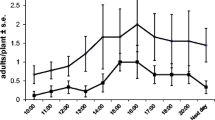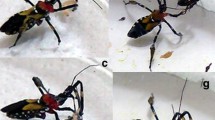Abstract
The mechanism of prey finding in adultHarmonia axyridis was investigated by presenting beetles with small gauze or polyethylene bags containing either aphidinfested leaves or healthy leaves alone together with empty control bags. Beetles were attracted to bags by olfactory and visual cues suggesting the presence of aphids, including the odor of aphid-infested leaves, the odor of aphids, the odor of healthy leaves, and the sight of leaves. Particularly effective in prolonging beetles's stay on bags visited was the odor of aphid-infested leaves. It is suggested that adults ofH. axyridis use olfactory and visual cues to detect prey before actual contact occurs. Use of such cues seems more advantageous than random searching, as has been reported in many previous studies of coccinellid foraging.
Résumé
Le mécanisme de découverte de la proie chez l'adulte d'Harmonia axyridis est étudié en donnant aux Coccinelles de petits sacs en gaze ou en polyéthylène contenant soit des feuilles infestées de pucerons, soit des feuilles saines seules, avec des sacs vides comme témoins. Les coccinelles sont attirées vers les sacs par des indicateurs olfactifs ou visuels suggérant la présence de pucerons, incluant l'odeur des feuilles infestées de pucerons, l'odeur des pucerons, l'odeur des feuilles saines et la vue des feuilles. L'odeur des feuilles infestées de pucerons est particulièrement efficace en prolongeant le séjour des Coccinelles sur le sac visité. Il est suggéré que les adultes d'H. axyridis utilisent des indicateurs olfactifs et visuels pour détecter leur proie avant que s'établisse le véritable contact. L'emploi de tels indicateurs semble plus avantageux que la recherche au hasard, comme cela a été indiqué dans de nombreuses études antérieures sur la quête alimentaire des Coccinelles.
Similar content being viewed by others
References
Banks, C.J.—1954. The searching behaviour of coccinellid larvae.—Brit. J. Anim. Behav., 2, 37–38.
Banks, C.J.—1957. The behaviour of individual coccinellid larvae on plants.—Brit. J. Anim. Behav., 5, 12–24.
Colburn, R. &Asquith, D.—1970. A cage used to study the finding of a host by the ladybird beetle,Stethorus punctum.—J. Econ. Entomol., 63, 1376–1377.
Dixon, A.F.G.—1959. An experimental study of the searching behaviour of the predatory coccinellid beetleAdalia decempunctata L.—J. Anim. Ecol., 28, 259–281.
Fleschner, C.A.—1950. Studies on searching capacity of the larvae of three predators of the citrus red mite.—Hilgardia, 20, 233–265.
Hodek, I.—1973. Biology of Coccinellidae.—Academia, Prague, 266 pp.
Kehat, M.—1968. The feeding behaviour ofPharoschmnus numidicus [Coccinellidae], predator of the date palm scaleParlatoria branchardi.—Entomol. Exp. Appl., 11, 30–42.
Nakamuta, K.—1982. Switchover in searching behavior ofCoccinella septempunctata L. [Coleoptera: Coccinellidae] caused by prey consumption.—Appl. Entomol. Zoll., 17, 501–506.
Author information
Authors and Affiliations
Rights and permissions
About this article
Cite this article
Obata, S. Mechanisms of prey finding in the aphidophagous ladybird beetle,Harmonia axyridis [Coleoptera: Coccinellidae] . Entomophaga 31, 303–311 (1986). https://doi.org/10.1007/BF02373340
Received:
Accepted:
Issue Date:
DOI: https://doi.org/10.1007/BF02373340




